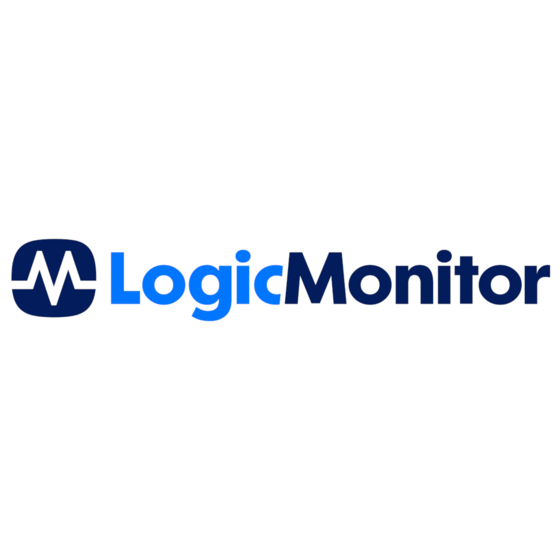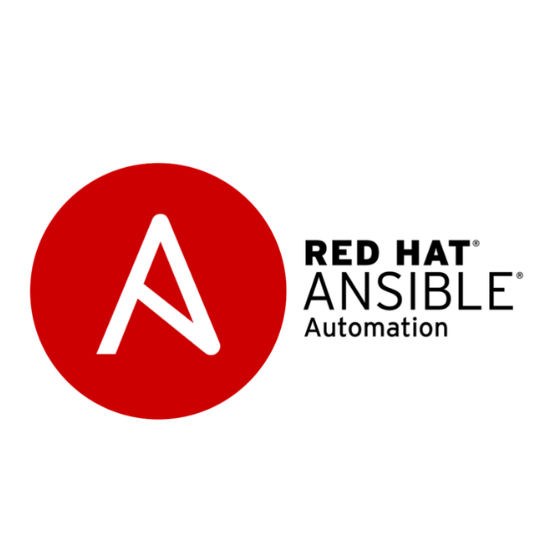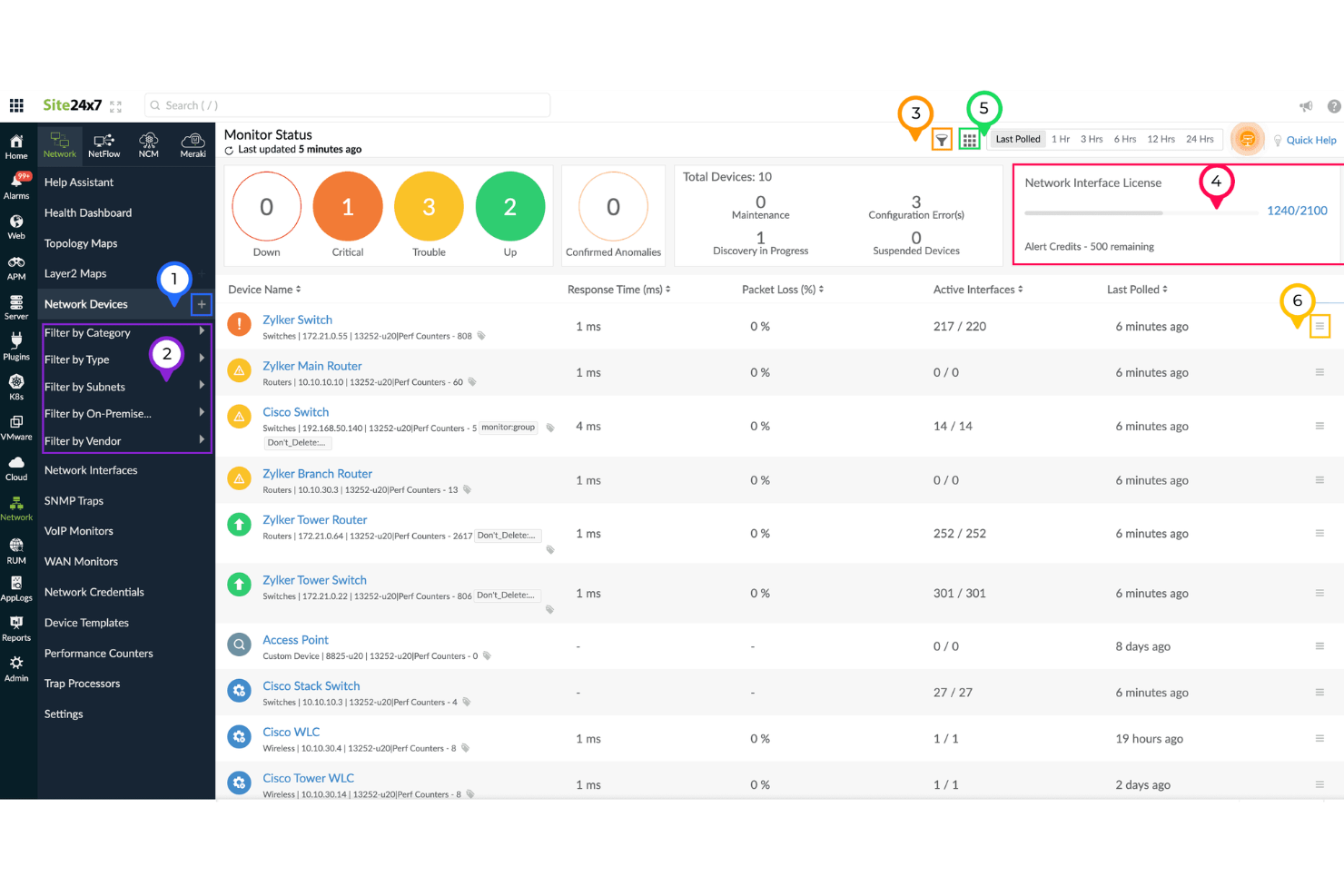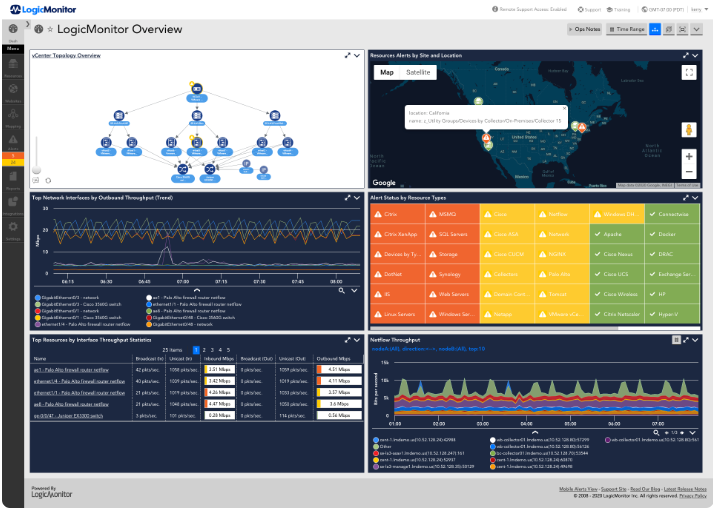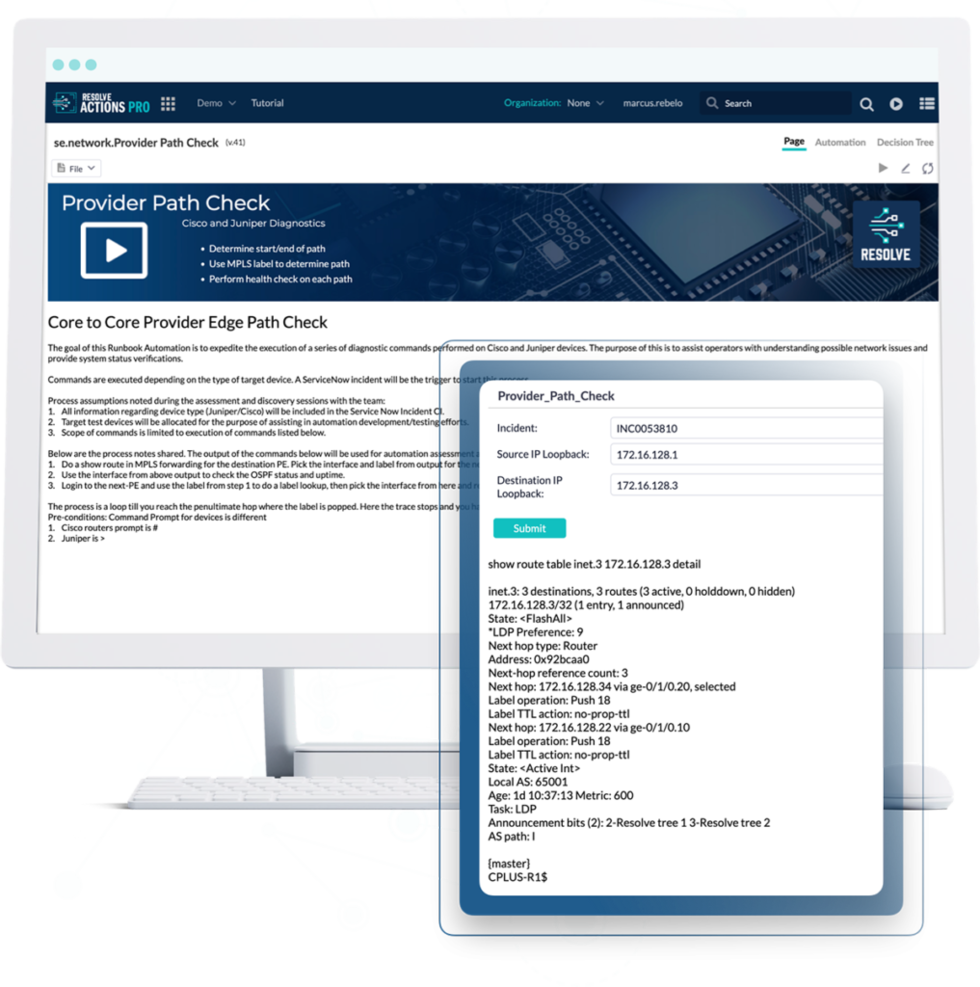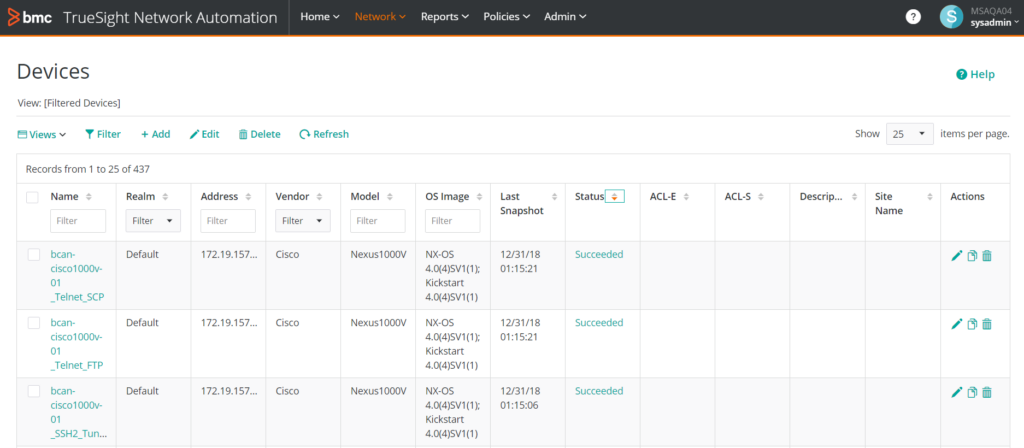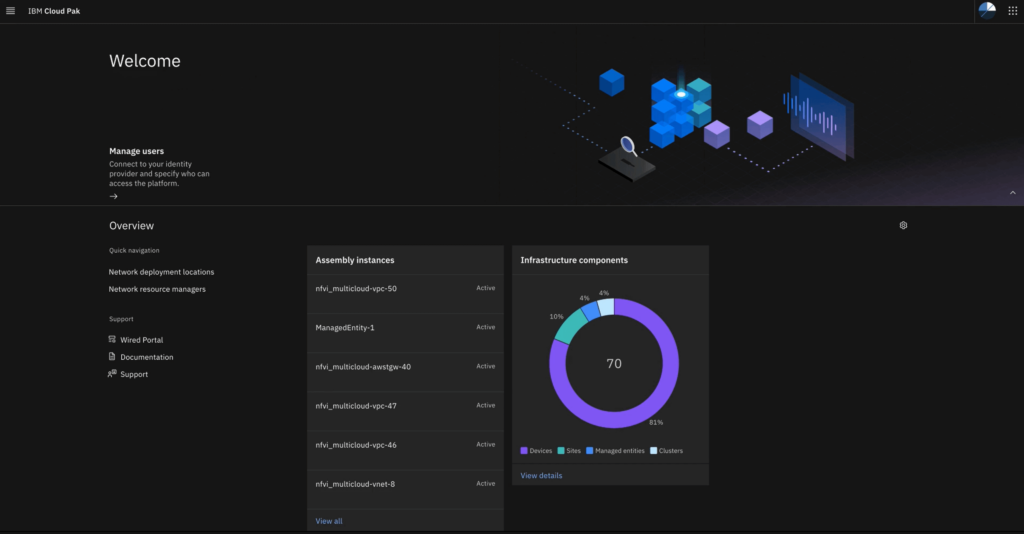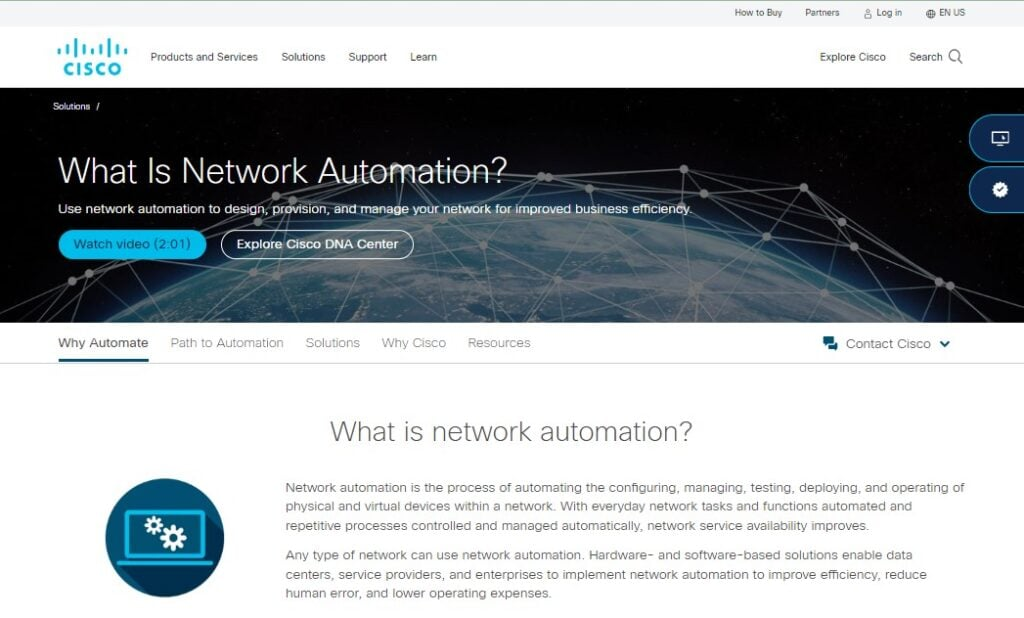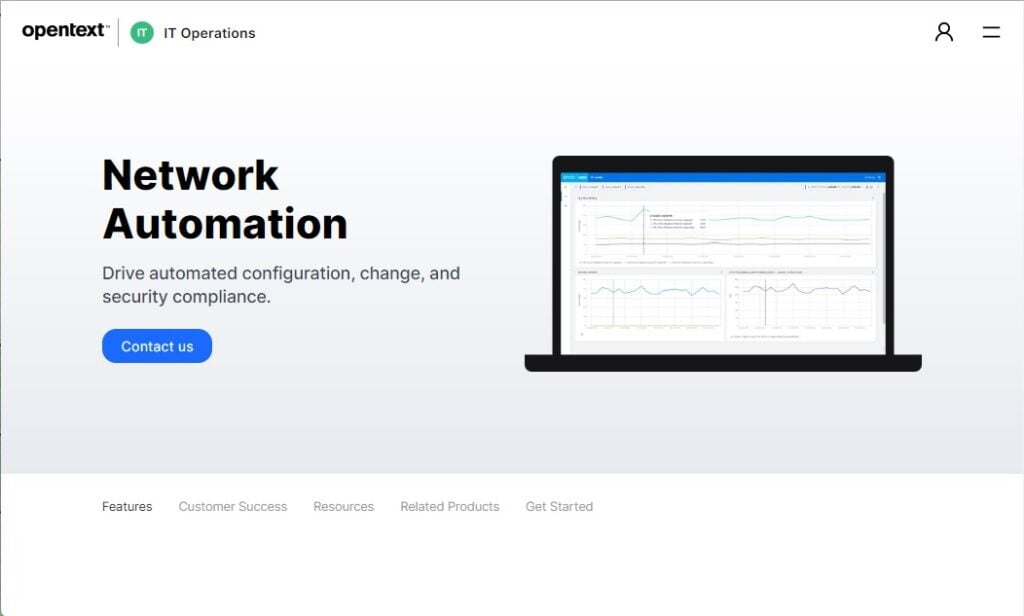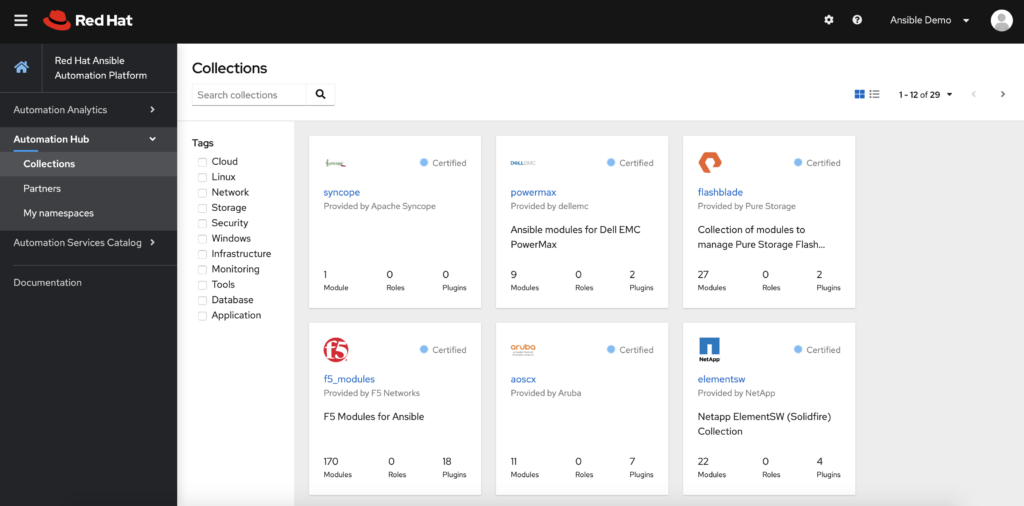10 Best Network Automation Software Shortlist
Here's my pick of the 10 best software from the 25 tools reviewed.
Our one-on-one guidance will help you find the perfect fit.
Navigating the complex maze of network devices and firewalls can be daunting without the right allies. That's where network automation tools come into play, acting as the bridge, often powered by robust APIs, to manage and orchestrate your infrastructure. Think of these tools as the maestros, ensuring every piece in the orchestra hits the right note, optimizing performance, and reducing the manual effort often leading to errors.
If you're feeling the pressure from endless configurations, patches, and updates, these solutions might just be the relief you've been searching for. Trust me, diving into these options can be a game-changer.
What Is A Network Automation Software?
Network automation software is a specialized solution designed to manage, configure, and optimize network devices and infrastructure with minimal manual intervention. Utilized primarily by network engineers, IT professionals, and system administrators, this software streamlines tasks such as deploying configurations, updating firewalls, and monitoring network health, ensuring that networks run efficiently and consistently meet the demands of modern digital environments.
Best Network Automation Software Summary
| Tool | Best For | Trial Info | Price | ||
|---|---|---|---|---|---|
| 1 | Best for automated network backups | Free trial + demo available | Pricing upon request | Website | |
| 2 | Best for monitoring and fault management | 30-day free trial | Pricing upon request | Website | |
| 3 | Best for hybrid infrastructure monitoring | Free trial available | From $3/resource/month | Website | |
| 4 | Best for rapid incident resolution | Not available | Website | ||
| 5 | Best for comprehensive network management | Not available | Pricing upon request | Website | |
| 6 | Best for AI-driven network operations | Not available | Pricing upon request | Website | |
| 7 | Best for interactive network visualization | Not available | Pricing upon request | Website | |
| 8 | Best for end-to-end network automation solutions | 45-day free trial | Pricing upon request | Website | |
| 9 | Best for scalable network orchestration | Not available | Pricing upon request | Website | |
| 10 | Best for modular network automation | Not available | Pricing upon request | Website |
-

Docker
Visit WebsiteThis is an aggregated rating for this tool including ratings from Crozdesk users and ratings from other sites.4.6 -

Pulumi
Visit WebsiteThis is an aggregated rating for this tool including ratings from Crozdesk users and ratings from other sites.4.8 -

GitHub Actions
Visit Website
Best Network Automation Software Reviews
Site24x7 is an all-in-one monitoring platform designed for IT operations and DevOps teams, offering comprehensive services for websites, servers, cloud resources, networks, and applications.
Why I Picked Site24x7: One of the standout features of Site24x7 is its network configuration management (NCM) tool. This tool allows you to automate the backup of device configurations, ensuring that you always have the latest settings saved. In the event of an unexpected change or outage, you can restore a previous stable configuration, minimizing downtime and maintaining network stability. Additionally, Site24x7's use of configlets (command snippets applied to network devices) enables you to automate and standardize configurations across multiple devices.
Standout Features & Integrations:
Other features include network compliance checks that help your team adhere to industry standards like Cisco IOS, SOX, HIPAA, and PCI DSS by flagging noncompliance issues and simplifying audits. The platform also offers IP address management (IPAM), allowing you to monitor and manage IP usage dynamically, identify conflicts, and visualize subnets for better capacity planning. Some integrations include ServiceNow, PagerDuty, Jira, Microsoft Teams, Slack, Nagios, AWS, Azure, Google Cloud Platform, Docker, Jenkins, and Kubernetes.
Pros and cons
Pros:
- Offers real-time alerts across various channels
- Customizable dashboards and reports
- Comprehensive monitoring for various systems
Cons:
- Limited customization in alerting mechanisms
- Complexity in initial setup for large environments
New Product Updates from Site24x7
Amazon CloudWatch Logs Integration
Site24x7 integrates with Amazon CloudWatch Logs, offering centralized log analytics, real-time alerts, and metric correlation. Monitor log groups and gain region-level insights within Site24x7. More details at Site24x7 What's New.
ManageEngine OpManager primarily functions as a network management platform, focusing on monitoring and fault identification. Its proficiency in recognizing faults in a system and ensuring steady connectivity makes it particularly suitable for those needing effective monitoring and fault management solutions.
Why I Picked ManageEngine OpManager: I selected ManageEngine OpManager after determining its merits among various tools in the network management domain. It stands out due to its refined monitoring capabilities and its knack for pinpointing faults swiftly.
This tool's specialization in monitoring and rapid fault identification justified its position as 'best for monitoring and fault management.'
Standout Features & Integrations:
ManageEngine OpManager is renowned for its robust monitoring capabilities, providing in-depth visibility into network health. It offers advanced endpoint monitoring, ensuring DevOps teams are immediately alerted of any potential issues.
Additionally, its integrations are diverse, allowing for collaboration across different platforms and tools.
Pros and cons
Pros:
- Effective endpoint monitoring suitable for DevOps environments
- Rapid fault detection reduces potential downtime
- Comprehensive network monitoring capabilities
Cons:
- Advanced features might be overwhelming for small networks
- Integration with some third-party tools could be smoother
- Might have a learning curve for new users
LogicMonitor is a cloud-based platform designed to support comprehensive monitoring across diverse IT infrastructures, both on-premises and in the cloud. Its specialty lies in providing insights into hybrid setups, making it especially adept at hybrid infrastructure monitoring.
Why I Picked LogicMonitor: In my search for top-tier monitoring tools, LogicMonitor quickly came to the forefront. I selected it after determining its unmatched capabilities in observing hybrid environments, a feat that not all tools can claim. Judging from its features and comparisons with other platforms, I'm confident in stating it's the best for hybrid infrastructure monitoring.
Standout Features & Integrations:
LogicMonitor's standout features include the ability to create playbooks that can automate responses to specific network conditions, ensuring quick rollbacks if necessary. The platform's support for multiple programming languages further augments its flexibility. Integration-wise, LogicMonitor efficiently ties in with SD-WAN solutions and offers extensive support for a myriad of nodes, streamlining the monitoring process.
Pros and cons
Pros:
- Supports multiple programming languages.
- Playbook creation for automated responses.
- In-depth hybrid infrastructure insights.
Cons:
- Some advanced features might be overkill for smaller setups.
- Might require additional training for optimal usage.
- Initial setup may be complex for some users.
Resolve is a dynamic network automation tool tailored to handle the twists and turns of intricate network environments. By focusing on simplifying provisioning, configuration changes, and device configurations, Resolve steps into the spotlight when rapid incident resolution becomes a priority.
Why I Picked Resolve: In the maze of network automation tools, Resolve caught my attention due to its laser-sharp focus on incident resolution. While many tools claim efficiency, I determined that Resolve stands a notch above, especially when it comes to swiftly addressing and rectifying issues. Its prowess in facilitating speedy incident resolution is what sealed its position as 'best for rapid incident resolution' in my books.
Standout Features & Integrations:
At the heart of Resolve are its intuitive automated workflows that significantly cut down response times during critical network incidents. Moreover, the software provides detailed visibility into device configurations, ensuring network engineers are always in the know.
Integrations-wise, Resolve gels well with a plethora of ITSM, monitoring, and orchestration tools, enhancing its adaptability in diverse IT ecosystems.
Pros and cons
Pros:
- Strong integrations with ITSM and monitoring tools
- Detailed visibility into device configurations
- Efficient automated workflows for quick response
Cons:
- Limited documentation available for certain integrations
- Some advanced features may be overkill for smaller networks
- Might have a steeper learning curve for beginners
TrueSight Automation for Networks is a robust network automation platform designed to streamline the tasks and challenges faced by network administrators. By offering a blend of network monitoring and automation functionalities, it addresses the complexities of managing vast and intricate networks, making it best suited for comprehensive network management.
Why I Picked TrueSight Automation for Networks: In the quest for a tool that excels in both monitoring and automation, my selection gravitated towards TrueSight Automation for Networks. From the array of tools I compared, this platform stood out due to its holistic approach to network management, addressing both the micro and macro challenges of the domain.
I chose it because it presents a refined balance between monitoring nuances and automation capabilities, making it the go-to solution for comprehensive network management.
Standout Features & Integrations:
One of the defining features of TrueSight Automation for Networks is its advanced CLI interface, which provides administrators with precise control and insights. Its real-time network monitoring feature keeps track of the health and performance of the network, alerting administrators to potential issues before they escalate.
For integrations, the platform connects effortlessly with a range of other ITSM tools and network devices, making it versatile in diverse IT environments.
Pros and cons
Pros:
- Integration with a plethora of ITSM tools and network devices.
- Real-time network monitoring ensures timely detection of potential network issues.
- Advanced CLI provides intricate control and insights for network administrators.
Cons:
- Initial setup and configuration can be intricate for some setups.
- Requires consistent updates to maintain compatibility with newer network devices.
- The platform's vast feature set may overwhelm new users.
IBM Cloud Pak for Network Automation is an integrated suite designed to automate network operations with the power of artificial intelligence. This platform not only streamlines common automation tasks but also provides AI-driven insights to make network operations more efficient, making it a top choice for AI-driven network operations.
Why I Picked IBM Cloud Pak for Network Automation: When selecting tools, I carefully judged each platform's capabilities, and IBM Cloud Pak for Network Automation stood out due to its AI-driven approach. After comparing it to other solutions, I determined that its unique combination of AI-enhanced insights and self-service capabilities set it apart from competitors. Based on its features and my analysis, I believe it's the best for AI-driven network operations.
Standout Features & Integrations:
Key features of IBM Cloud Pak include advanced automation tasks that reduce time-consuming manual processes, and AI-assisted decision-making that simplifies complex network management tasks.
Additionally, its integration capabilities allow for easy alignment with security policies, ensuring a secure and efficient network environment.
Pros and cons
Pros:
- Integration with security policies.
- Efficient handling of automation tasks.
- Advanced AI-driven network insights.
Cons:
- Some features might be seen as too advanced for straightforward network operations.
- The AI-driven features might have a learning curve.
- Might be complex for smaller network setups.
NetBrain is a network management platform that places a strong emphasis on providing interactive visualizations of complex network structures.
Its capability to represent networks visually, highlighting details like IP addresses and LAN connections, ensures administrators can understand and navigate their infrastructure efficiently, making it an ideal choice for those prioritizing interactive network visualization.
Why I Picked NetBrain: When selecting tools for this list, NetBrain emerged as a distinctive candidate due to its unparalleled visualization capabilities. Compared to others, it offers a unique, interactive representation of networks, making complex structures comprehensible.
Given this, I judged NetBrain as the best tool for interactive network visualization.
Standout Features & Integrations:
NetBrain's visualization tools don't just stop at basic network diagrams; they provide insights into IP address configurations, LAN structures, and even load balancers' statuses. Its Linux compatibility ensures that even networks built on open-source platforms can benefit from its features.
As for integrations, NetBrain collaborates well with a multitude of third-party software, ensuring that data from different sources can be cohesively visualized in one place.
Pros and cons
Pros:
- Integration capabilities with various third-party tools enhance its versatility
- Compatibility with Linux broadens its usability
- Detailed visualization includes intricate aspects like IP address and LAN configurations
Cons:
- Certain advanced features may not be necessary for very basic network setups.
- The high granularity of details might require a steeper learning curve
- Might be overwhelming for smaller networks or inexperienced users
Cisco is a renowned leader in the networking industry, offering comprehensive solutions that cater to various network needs. Their automation solutions provide an end-to-end approach, making them particularly adept at managing and optimizing entire network infrastructures, which aligns with their reputation as best for end-to-end network automation solutions.
Why I Picked Cisco: In the process of determining the most impactful tools, Cisco emerged as a front-runner due to its expansive and robust suite of network automation features. I judged and compared it with other tools and felt that its comprehensive approach to both virtual and physical network infrastructures set it apart.
I chose it because its capability to provide end-to-end solutions ensures fewer outages and a smoother networking experience.
Standout Features & Integrations:
Cisco shines with its NCM (Network Configuration and Management) efficiently manages network data and aids in rapid deployment and configuration across software-defined setups. Their virtualization technology ensures that both virtual network functions and traditional infrastructures are integrated.
Additionally, Cisco offers multiple integrations with other industry-leading platforms to further enhance its automation capabilities.
Pros and cons
Pros:
- Strong integrations with other industry tools.
- Advanced virtualization techniques for integrating virtual networks.
- Robust NCM capabilities for efficient network data management.
Cons:
- Higher upfront investment compared to some other solutions.
- Requires specialized training for full utility.
- Might be overkill for smaller network setups.
OpenText Network Automation provides an advanced platform for managing, automating, and orchestrating various network processes, both on-premise and in the cloud. With its ability to scale and adapt to growing network complexities, it positions itself as a leading choice for scalable network orchestration.
Why I Picked OpenText Network Automation: Navigating through a multitude of network automation tools, my judgment was anchored by OpenText's ability to efficiently orchestrate complex network tasks. I selected it based on its comprehensive suite of features and its distinct advantage of being able to scale according to network growth.
With its proficiency in managing larger networks, I believe it stands unmatched as the best for scalable network orchestration.
Standout Features & Integrations:
One of the striking features of OpenText Network Automation is its support for various operating systems, ensuring compatibility across different environments. The platform emphasizes automated processes, particularly in remediation, reducing manual intervention and potential errors.
In terms of integrations, it effortlessly pairs with a variety of IT management tools and network devices, amplifying its utility in diverse IT landscapes.
Pros and cons
Pros:
- Comprehensive integration capabilities with other IT management tools.
- Strong emphasis on automated processes, especially in remediation tasks.
- Broad support for multiple operating systems enhances its adaptability.
Cons:
- Frequent updates might necessitate consistent monitoring and management.
- Its on premise setup might require significant infrastructure investments.
- The extensive set of features might pose a learning curve for new users.
The Red Hat Ansible Automation Platform is a comprehensive solution for orchestrating and managing network resources. With its robust modular design, it aids businesses in automating multi-vendor networks and streamlining network change processes, making it optimal for modular network automation.
Why I Picked Red Hat Ansible Automation Platform: In the process of choosing tools for this review, the Red Hat Ansible Automation Platform stood out due to its modularity and extensive adaptability. The ability to handle modules with precision across a multi-cloud environment further differentiated it from other tools.
In my opinion, and after comparing it with other platforms, I determined that it's the best for modular network automation.
Standout Features & Integrations:
One of the significant features of the Red Hat Ansible Automation Platform is its modular approach, allowing businesses to customize and scale as per their requirements. This modularity extends to its prowess in managing multi-vendor networks and efficiently allocating network resources. Integration-wise, it's built for the multi-cloud world, connecting with major cloud providers and ensuring network consistency across platforms.
Pros and cons
Pros:
- Built for multi-cloud, ensuring consistency across different cloud platforms.
- Efficient handling of multi-vendor network environments.
- Modular design offers extensive customization and scalability.
Cons:
- Setup and initial configuration might be intricate for beginners.
- Some advanced modules may require additional training.
- Might be complex for those unfamiliar with Ansible's approach.
Other Noteworthy Network Automation Software
Below is a list of additional network automation software that I shortlisted, but did not make it to the top 10. They are definitely worth checking out.
- Terraform
For infrastructure as code
- Arista EOS CloudVision
For cloud-based network visibility
- Unimus
For network configuration backup
- BackBox
Good for intelligent automation and backup
- BlueCat
Good for adaptive DNS solutions
- Forward Networks
Good for network assurance and verification
- AppViewX
Good for visual network automation workflows
- SolarWinds Network Configuration Manager
Good for centralized network configurations
- BloxOne DDI
Good for cloud-first networking
- SolarWinds IP Address Manager
Good for scalable IP address management
- ZPE Systems
Good for remote network access solutions
- NVIDIA NetQ
Good for data-driven network operations
- Canonical Netplan
Good for straightforward YAML network configurations
- Liongard
Good for multi-environment IT management
- Ericsson
Good for adaptive network orchestration
Other Network Management Software Reviews
- Network Access Control Software
- Network Monitoring Software
- Intrusion Prevention Software
- Network Security Software
Selection Criteria For Choosing the Best Network Automation Software
When navigating the vast realm of network automation tools, the sheer number of options can feel overwhelming. Drawing from my personal experience, I've evaluated dozens of network automation tools, but I was specifically scouting for robust core functionality, exceptional key features, and user-centric design. Here's a detailed breakdown of the criteria that I believe are paramount when settling for a tool in this niche:
Core Functionality
- Automated Configuration Management: Ability to auto-deploy and modify network configurations across devices.
- Change Detection and Alerting: Notifies users whenever there's a change in the network configuration.
- Backup and Recovery: Automates backup processes for network configurations and offers quick recovery solutions in the event of failures.
- Policy Compliance Monitoring: Ensures that the network configurations comply with organizational or regulatory standards.
Key Features
- Real-time Analytics and Visualization: Provides insights into the network's performance, traffic flows, and potential bottlenecks.
- Integration Capabilities: Integrates with other IT management and network mapping tools in the organization's ecosystem.
- Role-Based Access Control (RBAC): Allows admins to define who can access what within the tool, ensuring security and accountability.
- Multi-vendor Device Support: Guarantees compatibility with devices from different manufacturers, enhancing versatility.
- Scheduled Tasks: Enables users to schedule specific automation tasks to run at predetermined times.
Usability
- Intuitive Dashboard Interface: For network automation tools, a centralized dashboard that gives an overview of network health, tasks, and alerts is critical.
- Drag-and-Drop Workflow Builder: Allows users to visually map out automation workflows, ideal for those without deep programming knowledge.
- Detailed Documentation and Learning Library: Considering the complexity of network tasks, a comprehensive knowledge base or learning library is invaluable for onboarding and troubleshooting.
- Responsive Customer Support: Quick and expert-level assistance is crucial, especially when dealing with network challenges that can have broad organizational impacts.
- Customizable Alert Notifications: The ability to customize how and when you receive alerts (e.g., SMS, email, in-app) based on the user's preference or the severity of the issue.
Remember, the best tool always aligns with the organization's specific needs, infrastructure, and future scalability requirements.
Most Common Questions Regarding Network Automation Software
What are the benefits of using the best network automation tools?
Using the best network automation tools provides several advantages:
- Efficiency and Time Savings: Automation eliminates manual tasks, saving valuable time and reducing human errors.
- Real-time Monitoring & Alerts: Get immediate notifications for network changes, breaches, or any other anomalies.
- Improved Compliance & Security: Tools often come with built-in features that enforce organizational and regulatory policies, and some integrate with protocols like SSH for secure data transfers.
- Enhanced Scalability: Easily manage and scale your network as your organization grows without having to drastically revamp the infrastructure.
- Integration Capabilities: Many tools can integrate with other platforms, including VMware NSX, Juniper, and more.
How much do these network automation tools typically cost?
The pricing for network automation tools varies greatly based on their features, scalability options, and target audience. Some tools offer basic functionalities and are priced lower, while enterprise-grade solutions with advanced features tend to be more expensive.
What are the common pricing models for network automation software?
Typically, network automation software pricing models include:
- Subscription-Based: Monthly or annually billed, often based on the number of devices or nodes being managed.
- Perpetual Licensing: A one-time purchase, sometimes with additional costs for updates or support.
- Freemium: Basic features are free, with a fee for premium functionalities.
Is there a typical price range for these tools?
Yes, while prices can vary widely, many tools have starter plans that range from $50 to $500 per month for smaller setups. Enterprise solutions, catering to larger organizations with more complex needs, can run into thousands of dollars monthly.
Which are the cheapest and most expensive software options?
The cheapest tools are often the freemium ones, where you can start for free and pay for additional features. On the expensive end, tools like VMware NSX, designed for large-scale enterprise environments, tend to be pricier because of their extensive capabilities.
Are there any free tool options for network automation?
Yes, there are several free tools available, especially those built around open-source models. Python, for example, has libraries and scripts that can be utilized for basic network automation tasks. However, for more comprehensive features and support, paid solutions are recommended.
Which tool is often considered the best network automation tool?
The “best” tool often depends on the specific needs of an organization. However, in terms of popularity, functionality, and robustness, tools that support SSH, integrate well with platforms like VMware NSX and Juniper, and offer extensive automation capabilities are often ranked higher by industry professionals.
Do these tools require knowledge of programming languages like Python?
Not necessarily. While having knowledge of Python can be beneficial, especially for custom scripts and integrations, many of the top network automation tools offer graphical interfaces, drag-and-drop workflow builders, and other user-friendly features that don’t require deep programming knowledge.
Summary
Selecting the best network automation software is crucial in today's fast-paced IT landscape. This guide aims to demystify the myriad of choices available and direct you to the tools that offer unparalleled functionality, key features, and usability.
Remember, the importance of network automation goes beyond mere convenience—it's about optimizing operations, bolstering security, and ensuring a smooth user experience.
Key Takeaways
- Core functionality matters: Always ensure that your chosen tool aligns with your primary goals. Whether it's SD-WAN capabilities, handling of network data, or software-defined functionalities, the core functions of the tool should match your needs.
- Evaluate usability and support: Beyond mere features, the software's interface, ease of onboarding, and customer support are vital. It's not just about having features but ensuring they can be easily accessed, understood, and utilized. Plus, responsive support can be a game-changer in critical situations.
- Consider the pricing spectrum: Network automation tools come in a variety of pricing models, from monthly subscriptions to one-time purchase options. Determine your budget, but also evaluate the value and ROI a tool can bring. Sometimes, investing a bit more can provide significantly enhanced results.
What Do You Think?
While I've put in a lot of effort to curate this list, the world of network automation software is vast and ever-evolving. If you believe I've overlooked a tool that deserves mention, or if there's a hidden gem you've encountered, we'd love to hear about it. Your insights not only benefit us but also the entire community seeking the best solutions. Please share your recommendations and help us refine our list for everyone's benefit.




